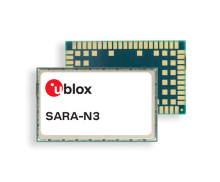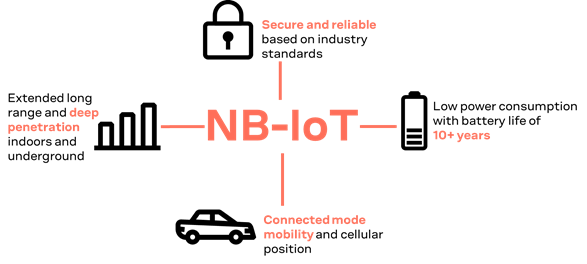
SARA-N310 module
Multi-band NB-IoT (LTE Cat NB2) module
Technology
|
23 Apr 2024
Narrowband IoT (NB-IoT) is a cellular technology specializing in communication between “things” that require small amounts of data, over long periods, in hard to reach places.
Narrowband IoT (NB‑IoT) is a Low Power Wide Area (LPWA) technology that works virtually anywhere. It connects IoT devices more simply and efficiently on already established mobile networks, and handles small amounts of fairly infrequent 2‑way data, securely and reliably. And the best is, it provides:

Many potential “connected things” are located in remote or hard‑to‑reach areas, at long distances from the next cellular base station, or in shielded areas, such as deep within buildings or underground structures. When there is coverage under the aforementioned circumstance, it is often poor and requires the device transmitter to operate at high power, draining the battery. Additionally, cellular networks are not optimized for applications that only transmit small amounts of infrequent data. Furthermore, the existing cellular standards don’t support the level of power saving capabilities that NB-IoT does, which makes these standards unsuitable for inexpensive devices that require battery lives of several years.
NB‑IoT has the ability to connect many more devices to the Internet of Things and make many new applications a reality. It is optimized for applications that need to communicate small amounts of data over long periods of time. Since it operates in licensed spectrum, it is secure and reliable, providing guaranteed quality of service.
Using other cellular air interfaces for a typical NB‑IoT application would be too expensive, as NB‑IoT applications don’t need all their capabilities. NB‑IoT applications focus on low speed, robust data transfer, and an appropriate level of reliability. The low device price and long lifecycle cuts operating expenses and reduces the risk of theft.
NB-IoT was first introduced as LTE Cat NB1 in the 3GPP Release 13 standard that also defined LTE-M (LTE Cat M1) - both are LPWA technologies in the licensed spectrum. With 3GPP Release 14, the LTE Cat NB2 standard has been set. Release 14 brings several improvements to the NB-IoT standard:

NB‑IoT is well suited for monitoring gas and water meters via regular and small data transmissions. Network coverage is a key issue in smart metering rollouts. Meters have a very strong tendency to turn up in difficult locations, such as in cellars, deep underground, or in remote rural areas. NB‑IoT has excellent coverage and penetration to address this issue.
NB‑IoT can help local government control street lighting, determine when waste bins need emptying, identify free parking spaces, monitor environmental conditions, and survey road conditions.
NB‑IoT connected sensors can send alerts about building maintenance issues and perform automated tasks, such as light and heat control. NB‑IoT can also act as the backup for the building broadband connection. Some security solutions may even use LPWA networks to connect sensors directly to the monitoring system, as this configuration is more difficult for an intruder to disable while being easier to install and maintain.
NB‑IoT provides a secure, low-cost and low-cost way to track people, animals and assets, whenever continuous tracking is not required. It is ideal to track objects that may not be moving all the time or where the long range and low power consumption of NB-IoT are of specific benefit.
NB‑IoT connectivity offers farmers and municipalities to capture data from an environmental sensor containing an NB‑IoT module that can send an alert, if anything is out of the ordinary. Such sensors could be used to monitor the temperature and humidity of soil, and in general to keep track of attributes of land, pollution, noise, rain, etc.

u-blox has worked with partners around the world to develop, promote and test NB-IoT: